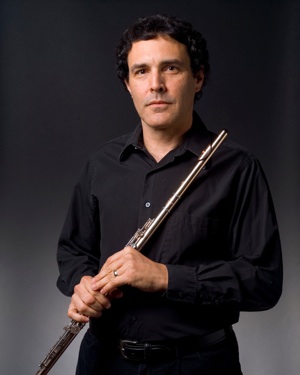A view from the top—contemporary mainstays
Morton Feldman is a musician’s musician. By this I do not mean that he is concerned with a theoretical approach, or that he references great works of the past. Rather, he is the opposite: he is so “in the moment” with his sound, and his process is so direct, that those steeped in form are thunderstruck by his immediacy. Performing one of his works, each slow, full note engenders the next, so the performer becomes part of the creative process, and we, the audience, feel that creative pull.
Feldman was one of five seasoned experimenters, each with a unique vision, performed by the San Francisco Contemporary Music Players Oct. 5 at Herbst Theater, as they inaugurated their 39th season. We heard minimalism with tape accompaniment, serialism, a post-modern song cycle, abstract color-field, and even a trombone trio.
John Harbison wrote of his own work, “[my works’] surfaces may be more transparent than their substance. Their apparent simplicity is an invitation to wade in, but the hope is that some will also feel an undertow.” This quote may be even more apt in describing Feldman, who wrote and spoke extensively about process, but hated to be equated with any theory.
Feldman, a close friend of painter Philip Guston and poet Frank O’Hara, was inspired by the American Abstract Expressionist movement of the 1950’s, and “painted” his compositions with the searching intensity of pure abstraction.
In the viola in my life (1) Nanci Severance bowed as gently as a held breath. Flute and piano answered with near-arbitrary pitches, sometimes a tri-tone higher, and soft thrums of brushed drum measured the air and died away. Feldman’s universe is elastic, each sound saturated with invisible dark matter.
Harbison, whom I quoted above, took a different approach in The Seven Ages. Written to the poetry of Louise Glück, he references the text without sacrificing a self-propelled musical motion. At a lecture/demonstration on Oct 4, the day before the concert, he described his process: he found himself memorizing the poems, and then fitting them into musical language that was concurrently developing in his thoughts.

Soprano Pamela Dellal joined flute, clarinet, violin, cello, piano and vibraphone for a piquant mix that lingered in the memory. When art changes form one treads chancy grounds. Composers roll the dice with libretti and often have to make their point the hard way. Glück’s poetry has force and subtlety—one relishes the spoken word, the liquid “l’s” and “m’s” like sighs of pleasure. Harbison’s earnest and programmatic approach is a very different animal.
Standing alone, the music is entrancing. But knit too close to text, it feels awkward. Dellal sang the difficult vocal line without missing a single hurdle.
Composer Edmund Campion also appeared in person for the U.S. premiere of his sharply witty 600 Secondes dans le vieux modèle, percussive unisons turning ghostly in the middle section, before returning, mirror-like, to the beginning. While it pays homage to strict serial techniques, it is more charming for not taking itself too seriously.
Flutist Tod Brody rapidly switched between flute, alto flute and piccolo in accompaniment to a pre-taped flock of flutists. Steve Reich’s Vermont Counterpoint is technically demanding and requires flawless timing. The minimal themes and repetition gave a fugue-like quality to this “wallpaper” music, a fabric that constantly changed shape and blurred.
And that trombone? Charles Wuorinen’s Trombone Trio (1985) for trombone, piano, xylophone and marimba, performed respectively by Hal Goff, Jeffrey Sykes, and percussionist Christopher Froh, had a curiously flattened perspective, like a Matisse still life. Piano and percussion doubled all their parts, creating one instrument that attacked with muffled hammer and died with a bell. Brass and percussion took turns, replacing harmony with opulent texture. Their sforzando attacks and lingering decays created a motion that carried the gruff and earnest trombone above marimba kerplops, a memorable and surprisingly sweet admixture.
The Contemporary Music Players return to Herbst on Monday, Nov. 2 at 8 p.m. in “Made to Order,” a program featuring three World Premieres written specifically for this group. A lecture/demonstration precedes the concert on Sunday, Nov. 1 at 4:30 at ODC Dance Commons, 351 Shotwell St, SF.
For more information on their current season, including program notes and sound clips, see www.sfcmp.org.
—Adam Broner
This article originally appeared in the Piedmont Post.
Photo: Flutist Tod Brody was among an array of top-flight musicians appearing with the SFCMP Oct 5; photo by John Martin.
